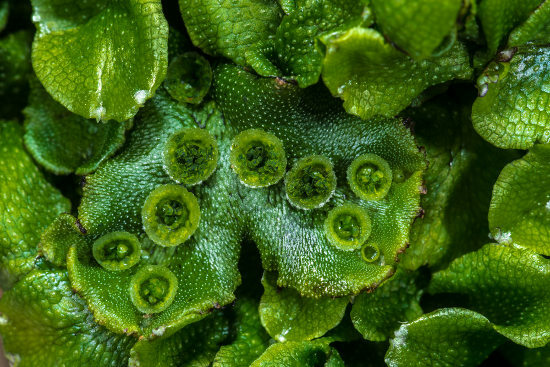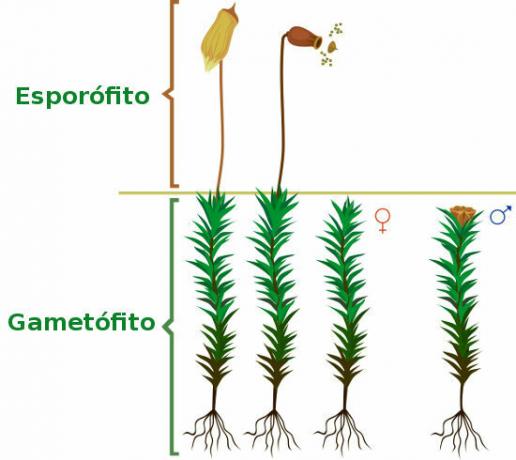The life cycle of bryophytes it presents alternation of generations and dependence on water. Bryophytes have the gametophyte (gamete-producing) stage as the dominant stage of the life cycle, that is, the most developed and lasting stage. Sporophytes (spore producers), in turn, are a passing phase of the cycle.
→ Summary of the life cycle of bryophytes
The life cycle of bryophytes stands out for having the following stages:
Male gametophyte produces anterozoid (male gamete);
Anterozoid swims to the female gametophyte towards the oosphere (female gamete);
Fertilization takes place;
Zygote develops into a sporophyte;
Sporophyte develops on gametophyte;
Meiosis occurs in the sporophyte capsule;
The capsule opens and the spores are released;
Spore falls into the environment and develops;
Protonema is formed;
Protonema develops and forms an adult gametophyte.
→ Examples of bryophytes
Bryophyte is a term used to identify avascular plants (vegetables that do not have transport vessel structures) and usually small in size. As examples of bryophytes, we can mention mosses (phylum Bryophyta), liverworts (phylum Marchantiophyta) and anthocerans (phylum Anthocerotophyta).

THE Marchantia is an example of a liverwort.
Read too:Is it dangerous to sleep with plants in the bedroom?
→ What is an alternating generation cycle?
The life cycle of bryophytes is characterized by the alternation of generations, that is, it has a gametophytic phase (which produces gametes) and a sporophytic phase (which produces spores). The gametophytic phase is more developed and lasting in the life cycle of these plants and is characterized by being a haploid phase. The sporophytic phase, in turn, is diploid and is a transient life phase.
→ Design of the reproductive cycle of bryophytes
Note a diagram of the reproductive cycle of bryophytes:

→ Bryophytes life cycle
The bryophytes are plants that can reproduceup in an asexual and also a sexual way. Asexual reproduction can occur, for example, through tissue fragments, which are used to generate a new plant and do not involve gametes. In sexual reproduction, however, we see the presence of gametes: anterozoids and oosphere. Next, we will briefly describe the life cycle of a moss, which is similar to the cycle of most other bryophytes.
In the reproduction of mosses, there is the presence of gametophytes (gamete-producing phase) and sporophytes (spore-producing phase). We observe female and male gametophytes: females have archegones, and males have antheridia. In antheridia, anterozoids (male gametes) are produced; in archegon, the oosphere (female gamete) is produced. In each archegon, a single oosphere is produced; in antheridium, several anterozoids are formed.
Bryophytes are plants that need water for reproduction, as the anterozoid needs this medium to move. Thus, in the presence of water, the anterozoid swims to the archegon. Upon reaching the archegon, the anterozoids are chemically attracted to the place where the oosphere is. The anterozoid then merges with the oosphere.

Observe the sporophyte with its capsule, where the spores are produced.
After fertilization, the formation of the embryo is observed, which develops and gives rise to the sporophyte. The bryophyte sporophyte remains attached to the gametophyte and has a capsule. It is in this capsule that the production of haploid spores occurs through a process of meiosis.
The spores are released from the capsule and, upon falling into a suitable environment, germinate and give rise to the protonema (first stage of development of the gametophyte of mosses and liverworts). The protonema becomes an adult gametophyte. This gametophyte develops into a mature gametophyte, able to continue the cycle.
→ Bryophytes gametophyte

Note the gametophyte phase of the moss and the sporophyte phase growing over the female gametophyte.
In bryophytes, the gametophyte is the longest-lasting life stage. This phase is capable of carrying out photosynthesis and may have a leafy or talus appearance. Leafy gametophytes are those that have filidia, which are species of primitive leaves. On the other hand, the talosus gametophyte does not have its body differentiated into kaolidium and filidium, presenting the body as a stalk.
→ Bryophyte sporophyte

Note the main parts of the sporophyte in the figure above.
The bryophyte sporophyte is a passing phase of the cycle. It develops on the gametophyte and is dependent on it, as it does not photosynthesize when mature. The sporophyte is basically formed by foot, arrow and capsule.
Foot: connects the sporophyte to the gametophyte;
Arrow: elongated portion between the capsule and the foot (Antócera do not have arrows);
Capsule: place where spores are produced.
Read too:toxic plants
→ Differences between the cycle of bryophytes and that of pteridophytes
At pteridophytes and bryophytes have life cycles with some similarities and differences. Among the similarities, we can highlight the fact that the cycle of both, as well as that of other groups, presents alternation of generations. In addition, both bryophytes and pteridophytes need water to reproduce.
With regard to differences, we can highlight:
Bryophytes have the gametophyte as the dominant generation, unlike pteridophytes, which have the sporophytes as the dominant generation.
Pteridophytes have a free-living sporophyte, unlike bryophytes, which have a gametophyte-dependent sporophyte.
→ General characteristics of bryophytes

Mosses are examples of bryophytes, plants that stand out for the absence of conducting vessels.
Bryophytes are quite simple plants. Its best-known representative is the moss. The characteristics of this group of plants are:
Absence of sap conducting vessels (avascular plants);
Absence of seeds, flowers and fruits;
Dependence on water for reproduction;
Life cycle with alternating generations (gametophytic phase and sporophytic phase);
Gametophyte is free and is the lasting phase of the cycle;
Sporophyte is gametophyte dependent and represents a brief phase of the cycle.


